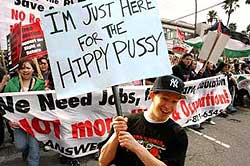Reinstate conscription, these folks say, and we’d alleviate the disproportionate burden the current system places on minorities.
Funny: I watch network news nearly every night, but I’ve not seen many soldiers of color on the Iraq segments. Most of those guys in Hummers, or recuperating at Walter Reed, look REALLY pale.
And DOD statistics confirm this: 74.4 percent of U.S. military deaths in Iraq, and 73.0 percent of the wounded, are white. Blacks and Hispanics make up 9.7 percent and 10.8 percent of the dead, respectively. (Table 1.)
To be sure, whites accounted for a significantly larger share of battlefield deaths in Korea and Vietnam—but their share of the U.S. population was greater at that time too. (Table 2.)
A Heritage Foundation study released last October compared the demographic characteristics of recent military recruits with the total U.S. population. We present some of their data, along with DOD statistics on U.S. military casualties by race, in Table 3. [Who Are the Recruits? by Tim Kane, Ph.D. Center for Data Analysis Report #06-09]
In 2004 about three-quarters (75.6 percent) of the adult population, and 73.1 percent of recruits, were classified as white. This indicates a population/recruit ratio of 0.97—with 1.00 indicating an exactly proportional representation. The casualty/population ratio for whites is also 0.97.
Bottom line: whites are proportionately represented among both recruits and casualties.
Blacks, on the other hand, account for 14.5 percent of recruits, but only 12.17 percent of the population, for a recruit-to-population ratio of 1.19. Yet only 8.4 percent of casualties are Black—a casualty-to-population ratio of only 0.69.
The same pattern holds for Hispanics, although they may be undercounted in DOD casualty figures due to a reluctance to identify themselves by ethnicity.
Asians are underrepresented both among recruits and, more dramatically, among casualties.
Bottom line: Blacks and Hispanics are overrepresented among recruits, but underrepresented among casualties.
(Note that Hispanics are often double-counted, because they can be of any race. What we really need to refute Rangel is the “white non-Hispanic” military death rate, but this is not provided. However, we can infer that it may above the white non-Hispanic share of the population from the fact that “non-Hispanics” constitute 85.9 percent of the overall population and 93.12 percent of the combat death.)
This bifurcation does not impugn the bravery of Black and Hispanic soldiers. Rather it points out the opportunities the volunteer army affords minorities.
And if you are more likely to be a "lifer", it makes more sense to look for support and logistical roles. And African-Americans and Latinos are more likely to look toward becoming "lifers":
Combat units have gotten whiter because a lot of young white guys join up to "play Rambo" for four years and then go to college using military tuition benefits. In contrast, more blacks view the military as a long-term career.
If you intend to stay in until you are 40 or 50, it makes a lot of sense to pursue a specialty that offers plenty of desk jobs. Crawling on your belly and sleeping in the mud might sound like fun if you aren't staying past your early 20s, but it gets old awfully fast as you yourself get older.
College-educated Blacks, for example, make up 12 percent of the officer corps, yet only 7.6 percent of college graduates are Black. Black enlisted men are under-represented in the military and Special Forces, and over-represented in logistical support and administrative occupations—skills that are valued in the civilian world. A draft would obliterate those advantages.
So which racial groups are disproportionately casualties of the Iraq war?
Native Hawaiian and Pacific Islanders (Samoans) are the most likely to be killed or wounded. They account for 1.02 percent of Iraq casualties, 4.5-times their population share. They also volunteer at far greater rates than other races.
Second place goes to American Indian/Alaska natives, whose share of the dead and wounded is 1.36-times their share of the population.
But the numbers involved are very small. Neither group is large enough to provide a significant share of soldiers.
Note, however, that both groups inhabit sparsely populated, predominately rural, regions of the country—and that, rather than race per se, is the key factor.
Heritage finds that rural areas contribute far more recruits relative to population than urban areas. Completely urbanized areas have 39.1 percent of the population but accounted for 27.3 percent of recruits in 2005, producing a 0.70 recruit/population ratio. As urbanization decreases the recruit/population rises, reaching 1.56 in the most rural parts of the country.
The urban/rural death gap is the subject of a study sponsored by the University of New Hampshire’s Carsey Institute, which specializes in overlooked parts of the country. Among the findings: "The death rate for rural soldiers (24 per million adults aged 18 to 59) is 60 percent higher than the death rate for those soldiers from cities and suburbs (15 deaths per million)." [William O’Hare and Bill Bishop, "U.S. Rural Soldiers Account for a Disproportionately High Share of Casualties in Iraq and Afghanistan," Carsey Institute, Fall 2006. PDF]
One of the study’s authors, demographer William O’Hare, is quoted:
"…..The opportunity differential between rural and urban America is probably higher now than at any time in the past. Our study highlights the price some young folks and their families are paying for lack of opportunity in rural America." [Rural America Pays the Price for War in Iraq, Alternet.org, By Tom Engelhardt, January 27, 2007]
Unfair? Maybe. But it’s the economy, not race, stupid.
Two more thoughts:
1. If we want a winning military, does it really make sense to fill it with people who don't want to be there?
2. Where do different races and ethnics get along better--in the military or on university campuses?











No comments:
Post a Comment